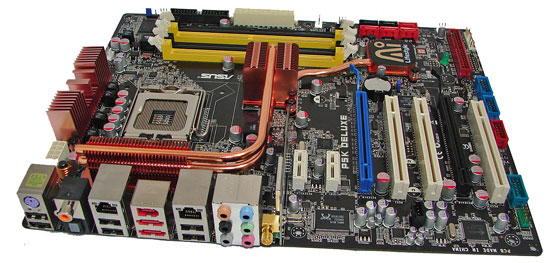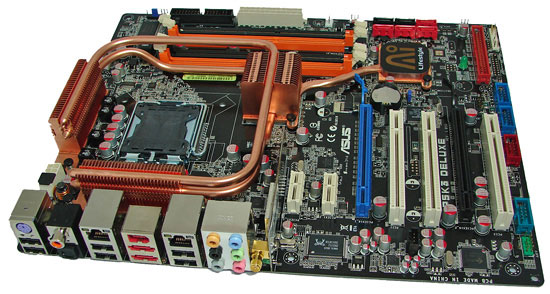Intel P35: Intel's Mainstream Chipset Grows Up
by Gary Key & Wesley Fink on May 21, 2007 3:45 PM EST- Posted in
- CPUs
ASUS P5K & P5K3 Deluxe Features
| ASUS P5K Deluxe and P5K3 Deluxe | |
| Market Segment: | Enthusiast - $229.99~$249.99 |
| CPU Interface: | Socket T (Socket 775) |
| CPU Support: | LGA775-based Pentium 4, Celeron D, Pentium D, Pentium EE, Core 2 Duo, Core 2 Extreme |
| Chipset: | Intel P35 MCH and Intel ICH9R |
| Bus Speeds: | Auto, 200 ~ 800 in 1MHz increments |
| Memory Speed: DDR2 | Auto, 200 FSB - 667/800, 266 FSB - 667/800/889/1067 333 FSB - 667/800/833/1000/1067/1111/1333 |
| Memory Speed: DDR3 | Auto, 200 FSB - 800, 266 FSB - 800/889/1067 333 FSB - 800/833/1000/1067/1111/1333 |
| PCIe Speeds: | 100MHz~150MHz in 1MHz Increments |
| Core Voltage: | Auto, 1.1000V to 1.7000V in 0.0125V increments |
| CPU Voltage Damper: | Auto, Enable, Disabled |
| Core Voltage Reference: | Auto, .63x, .61x, .59x, .57x |
| CPU Clock Multiplier: | Auto, 6x-12x in 1X increments if CPU is unlocked, downwards unlocked, Core 2 Duo |
| DRAM Voltage: DDR2 | Auto, 1.80V ~ 2.55V in various increments |
| DRAM Voltage: DDR3 | Auto, 1.50V ~ 2.20V in various increments |
| DRAM Timing Control: | Auto, 9 DRAM Timing Options |
| Transaction Booster: | Auto, Enable 0/1, Disabled 0/3 |
| NB Voltage: | Auto, 1.25V, 1.40V, 1.55V, 1.70V |
| FSB Voltage: | Auto, 1.2V, 1.3V, 1.4V, 1.5V |
| Memory Slots: | Four 240-pin DDR2 DIMM Slots Dual-Channel Configuration Regular Unbuffered Memory to 8GB Total |
| Expansion Slots: | 2 - PCIe X16 (1x16, 1x4 electrical for CrossFire or Multi-GPU) 2 - PCIe x1 3 - PCI Slot 2.2 |
| Onboard SATA/RAID: | 6 SATA 3Gbps Ports - ICH9R (RAID 0,1, 10, 5) 2 e-SATA 3Gbps Port - JMicron JMB363 |
| Onboard IDE: | 1 ATA133/100/66 Port (2 drives) - JMicron JMB363 |
| Onboard USB 2.0/IEEE-1394: | 10 USB 2.0 Ports - 6 I/O Panel - 4 via Headers 2 Firewire 400 Ports by Agere FW322 - 1 I/O Panel, 1 via Header |
| Onboard LAN: | Marvell Gigabit Ethernet 88E8056 - PCI Express Gigabit Ethernet controller Realtek RTL8187 PCI Gigabit Ethernet controller |
| Onboard Audio: | ADI 1988B - 8-channel HD audio codec |
| Power Connectors: | ATX 24-pin, 8-pin EATX 12V |
| I/O Panel: | 1 x PS/2 Keyboard 1 x WiFi Port 2 x e-SATA 1 x S/PDIF Coaxial/Optical - Out 1 x IEEE 1394a 1 x Audio Panel 2 x RJ45 6 x USB 2.0/1.1 |
| BIOS Revision: | v.0304 |
| Board Revision: | v1.00 |
ASUS has loaded down this board with a wide array of options that includes their WiFi-AP Solo wireless network solution, dual Gigabit LAN, ADI AD1988B HD audio codec with improved circuitry, and the complete AI Lifestyle suite. The BIOS is fairly comprehensive and is enthusiast oriented. The two most important features we used during testing are the Transaction Booster option that on average improved unbuffered memory scores and latency by 4%~7% along with the CPU Voltage Damper setting that greatly reduced Vcore droop. We noticed under load testing with our QX6700 that average Vcore droop was around .04V and with CPU Voltage Damper enabled the average VCore droop hovered around .02V.
ASUS P5K Deluxe Layout and Features
 |
| Click to enlarge |
ASUS did a really nice job in the layout of this board as all features on the board except for the clear CMOS jumper are easily reached. This board features an eight-phase power regulation system and 100% use of conductive polymer aluminum capacitors that provided excellent stability during testing at stock and overclocked speeds. During our overclocking tests we found the passive heatpipe system worked well but additional airflow was required to ensure stability during overclock testing.
The board installed easily into our Cooler Master CM Stacker 830 case and cable management was very good for power, optical, and hard drives. Our only concern was that two out of six SATA connectors were partially blocked when installing an 8800 GTX. The ports could still be used with an angled SATA connector, but it seems only standard SATA cables are included in the packaging. Our larger heat sinks did fit on this board, but there was not much space left around the CPU area after installation. We will go in depth about the board and its features in our P35 roundup before Computex.
ASUS P5K3 Deluxe Layout and Features
 |
| Click to enlarge |
The P5K3 Deluxe is based on the same board design as the P5K but includes a wrap around heatpipe system that provided a slight benefit during overclock testing provided airflow was adequate. We saw an average temperature reduction of about 2C when measuring the MCH under load when compared to the P5K board. However, the drawback is that installation of a large heatsink is cumbersome with this design. Our current inventory of heat sinks worked but be prepared for some minor cuts when installing them. Of course, the real news about this board is support for DDR3 memory and some interesting test results as we will see shortly.










58 Comments
View All Comments
Wesley Fink - Monday, May 21, 2007 - link
Early boards will be expensive, just like always. The prices will likely drop to the same levels as current P965 boards they replace, with a broad range for P35 boards from basic to "Asus Commando" level gaming boards. It is too early to be discouraged.Comdrpopnfresh - Tuesday, May 22, 2007 - link
I'm willing to bet we'll see them replacing the older boards quickly too. If intel and other manufacturers really want DDR3 to go through, you'll see DDR2 boards disappearing quickly. Its like what happened to s939. Basically the same chips were used for AM2, but the boards and chips quickly dried up and disappeared. The same can be said or PCI-e. In the beginning there wasn't much of a real world benefit, just the theoretical bandwidth increase. Because developments in AGP ceased, we might never know if the switch was necessary.Comdrpopnfresh - Monday, May 21, 2007 - link
If something other than NAND flash could be used, it would be very interesting to see a pci-e 1x board that can house DDR2 memory for use in turbo memory. That way, when people upgrade their ~35 boards to DDR3 when performance and price changes, the DDR2 can be used further. This would make a lot of sense too, because unlike Gigabyte's i-RAM device and logical ramdrives, the high speed, low latency properties of RAM could be used for turbo memory as a way around the 8gb limit of RAM on these cards. And since they are not used for storage, merely access, no redundancy on power supply is needed as with the i-RAM. Someone should start development on this...Comdrpopnfresh - Monday, May 21, 2007 - link
Why would the TDP on the P35 higher if it has no integrated video? Will third-party manufactures implement their own SLI into the P35 given that the reference model only had on x16 pci-e slot? Also, when can we expect to see pci-e2 and more than 4 dimm slots on intel mobos?yacoub - Monday, May 21, 2007 - link
Including a jumper to change the strap setting for the fsb is a nice feature on the MSi board. A little disappointed in the memory comparison test that that board had the lowest bandwidth and most latency. Is that something BIOS updates can improve or is that generally hardware (i.e. board design related)?Gary Key - Monday, May 21, 2007 - link
It is all BIOS tuning in regards to the MSI board. Our first results with the board had the memory performance being equal to the 945P boards. Two BIOS releases later and the improvements have been remarkable. I think MSI is about two BIOS spins behind ASUS and Gigabyte now. Gigabyte finally caught up but ASUS still has the better feature set and options in my opinion.michal1980 - Monday, May 21, 2007 - link
hardocp, seems to take a 180 different outlook on these boards. so werid.skaterdude - Monday, May 21, 2007 - link
What's so weird? Kyle is an extension of AMD's marketing department. He has not cared for Intel in a very long time, at least since he was caught cheating on some Intel benchmarks and was hung out to dry for it. Personally, it is alright to have a favorite company to root for but to do so in such an open and bias way is wrong if you are not running a company specific website. I would not have an issue at all if it was called HardAMD, at least you know what you are viewing is not tainted by free trips, booze, products, and general hostility against a company.
Back on subject....The P35 is a nice upgrade and it may not set the world on fire but it appears Intel listened and improved on a chipset they could have let ride for a lot longer. DDR3 will be interesting and at least the kinks will be worked out by the time X38 and the new processors get here. If I had not already bought a 965 board then P35 would have been the one. I am still miffed about not having a native IDE port as JMicron just plain sucks most of the time.
strikeback03 - Tuesday, May 22, 2007 - link
the P35 does not have native IDE either, and why use an IDE drive anyway?Spoelie - Monday, May 21, 2007 - link
ahum, AMD biased? After reading some of their recent gpu reviews, I thought it was the other way around... Check yourselfanyway, not a worthy upgrade, but a worthy new board. Which is what you could reasonably expect.